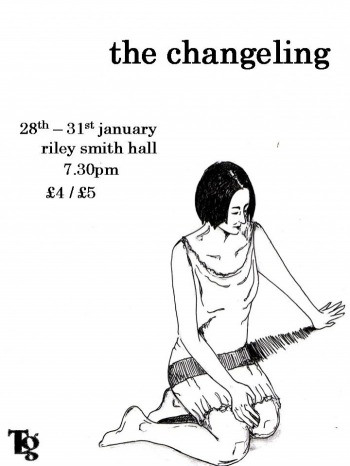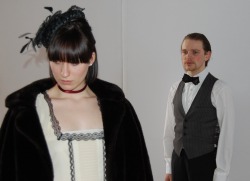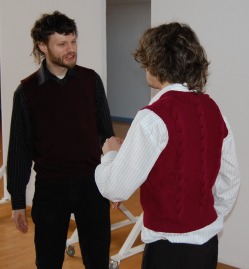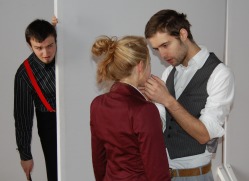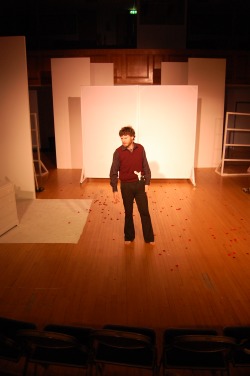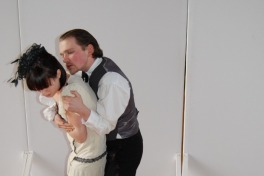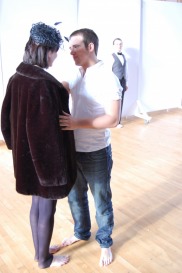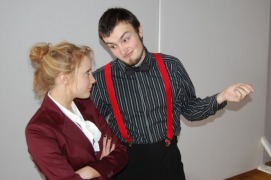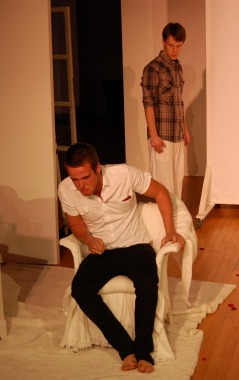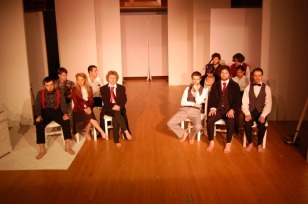THE CHANGELING
By Thomas Middleton And William Rowley
director: nick coupe
assistant director: grace wright
producer: claire martin
production manager: emily mcculloch
costume and poster design: lucy arnold
vermandero: liam mulvey
beatrice-joanna: laura nagel
de flores: edmund digby-jones
diaphanta: laura marston
alsemero: george chilcott
jasperino: nathan wood
alonzo de piracquo: jimmy walters
tomazo de piracquo: james bober
alibius: james huntrods
isabella: naomi stafford
lollio: rory greenfield
antonio: pierre tailleux
director’s note
i first came across this play at school, where i studied it as my english set text – a process that involved learning the themes, symbols and quotes, and then reeling them off in the exam. certain images of the play have stuck with me, however – the obsessive servant stalking his spoilt mistress, the husband being cuckolded on his honeymoon, and the seemingly irrelevant madhouse, where half the inmates are feigning madness to get near the doctor’s wife. it seemed to be a play that i wanted to explore in more detail, and i have thoroughly enjoyed the opportunity of doing so over the past few months. peter morrison describes the play as ‘itself no beauty; it is a mutant made of farce and fury, a monster made of passionate shrieks and blank stares, a freak half finished with an arm too many or a leg too few.’ (one of those quotes i learnt). i think that the real power of the play is in its variety, from the bloodthirsty to the tragic, and occasionally funny – the subplot’s farce weighed against the main plot’s fury…
i’m very grateful for the support and funding that tg have provided, and for all the hard work that’s gone into this play - the cast have been an absolute pleasure to work with, and the production team have worked tirelessly (and often thanklessly) to keep me sane and bring it all together.
REVIEWS
Leeds Student Newspaper February 6th 2009
Nali Sivathasan
FOUR STARS
Described as Middleton’s greatest tragedy, The Changeling is the latest play to be tackled by LUU Theatre Group (TG), bringing the exotic events of sunny Alicante to the currently chilly climes of Leeds. The play’s title refers to the changes many of the characters undergo as they battle through love, deception and revenge. Complicated love triangles between characters were cleverly clarified with the use of music.
The Changeling’s title figure is Antonio – the changeling – who feigns madness in order to enter the madhouse run by the believably foolish Alibius, played by James Huntrods, so that he can seduce his pretty wife Isabella. Despite Pierre Tailleux’s portrayal of madness and sanity as Antonio, the real changeling of the play is actually Beatrice-Joanna in the main plot. Her pursuit of her lover, Alsemero, sets into motion a series of uncontrollable tragic actions. The plot is complicated further by the role of De Flores, the servant who is infatuated with Beatrice-Joanna. Edmund Digby-Jones’s sympathetic yet disturbing performance of infatuation is particularly notable, becoming the lever on which change hinges in the play, and his blackmail of Beatrice becomes believable in the eyes of the audience.
Plaudits go to the director in the second half, who successfully created the illusion of an authentic asylum in the auditorium, making the audience walk through a cast of deranged inmates. Emotional intensity was aided by Liam Mulvey’s commanding role as Vermandero, Beatrice’s father, whose outward projection of dominance is finally shattered by the plays outcome.
Despite such intensity, there were several moments of comic relief, especially in the Antonio-Isabella madhouse subplot. Rory Greenfield’s characterisation of Lollio, Alibius’ assistant, also injected the requisite bawdy humour that is a staple part of Middleton’s play. However the lack of resolution to the comic plot felt unsatisfying in contrast to the tragic climax of the main plot.
The action was propelled by the director’s flair for originality that distinguished it from its source and any potentially tired interpretations of the play. A minimalistic white background was particularly effective, evoking the idea of purity that is threatened and irrevocably tainted by change. The use of petals for blood was striking against this background and added an artistic edge and mystical beauty to the violence that was prevalent throughout the play.
